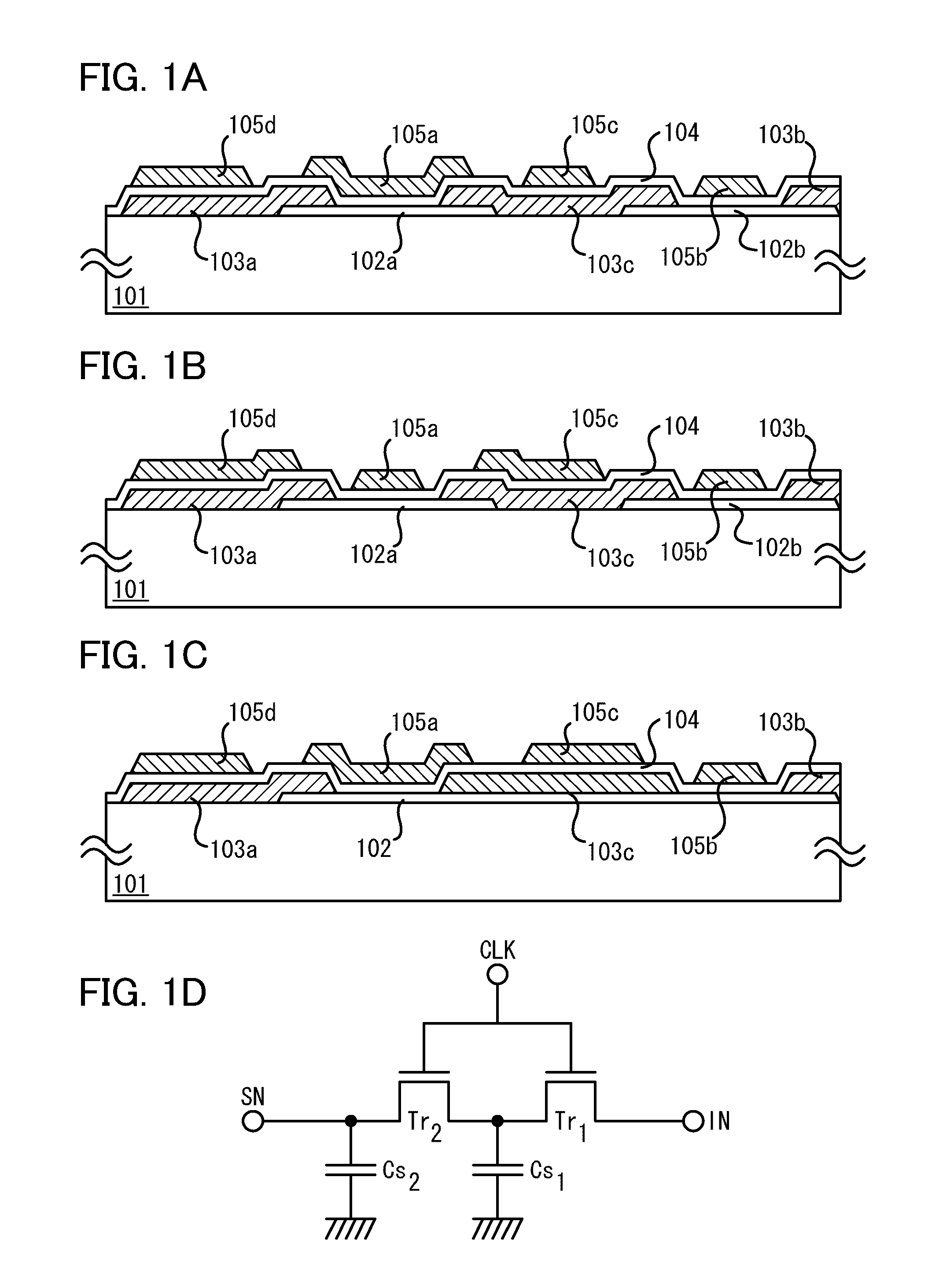Semiconductor device and manufacturing method thereof
- Summary
- Abstract
- Description
- Claims
- Application Information
AI Technical Summary
Benefits of technology
Problems solved by technology
Method used
Image
Examples
embodiment 1
[0081]FIG. 1A is a cross-sectional view of a semiconductor device of this embodiment. The semiconductor device includes a first oxide semiconductor layer 102a and a second oxide semiconductor layer 102b over a substrate 101. Further, a first layer wiring 103a is provided in contact with the first oxide semiconductor layer 102a, a first layer wiring 103b is provided in contact with the second oxide semiconductor layer 102b, and a first layer wiring 103c is provided in contact with the first oxide semiconductor layer 102a and the second oxide semiconductor layer 102b.
[0082]A gate insulator 104 is provided over the first oxide semiconductor layer 102a, the second oxide semiconductor layer 102b, and the first layer wirings 103a to 103c. A second layer wiring 105a, a second layer wiring 105b, a second layer wiring 105c, and a second layer wiring 105d are provided over the gate insulator 104.
[0083]The semiconductor device includes two transistors and two capacitors. The second layer wiri...
embodiment 2
[0089]In this embodiment, a method for manufacturing an offset transistor and an aligned transistor over one oxide semiconductor layer will be described with reference to FIGS. 2A to 2D.
2A>
[0090]An oxide semiconductor layer 202 is formed over a substrate 201. A variety of substrates can be used as the substrate 201. For example, a single crystal silicon wafer, a glass substrate, a silicon on insulator (SOI) substrate, or the like can be used. The substrate 201 preferably has an insulating surface, and in the case where a semiconductor substrate or a conductive substrate is used, an insulating layer (hereinafter, referred to as a first insulating layer) is preferably provided on its surface. A circuit may be formed over the substrate 201, and the first insulating layer may be provided over the circuit.
[0091]The first insulating layer is preferably formed using an oxide, and it is much preferable that the first insulating layer include excessive oxygen. The hydrogen concentration of t...
embodiment 3
[0112]In this embodiment, an example where the circuit in FIG. 1D is used will be described. FIG. 3A illustrates a circuit of a memory element including the circuit in FIG. 1D. This memory element includes a circuit including a first transistor 301, a second transistor 302, a first capacitor 304, and a second capacitor 305 (a portion surrounded by a dotted line in the drawing) and a read transistor 303. The portion surrounded by the dotted line in the drawing is similar to the circuit in FIG. 1D.
[0113]The first transistor 301 is an offset transistor, and the second transistor 302 is any of an aligned transistor, an overlap transistor, and an offset transistor. Each of the first transistor 301 and the second transistor 302 includes an oxide semiconductor layer as described in Embodiment 1 or 2.
[0114]When data is input, a potential of a signal terminal CLK of gates of the first transistor 301 and the second transistor 302 is controlled so that the first transistor 301 and the second t...
PUM
 Login to View More
Login to View More Abstract
Description
Claims
Application Information
 Login to View More
Login to View More - R&D
- Intellectual Property
- Life Sciences
- Materials
- Tech Scout
- Unparalleled Data Quality
- Higher Quality Content
- 60% Fewer Hallucinations
Browse by: Latest US Patents, China's latest patents, Technical Efficacy Thesaurus, Application Domain, Technology Topic, Popular Technical Reports.
© 2025 PatSnap. All rights reserved.Legal|Privacy policy|Modern Slavery Act Transparency Statement|Sitemap|About US| Contact US: help@patsnap.com



